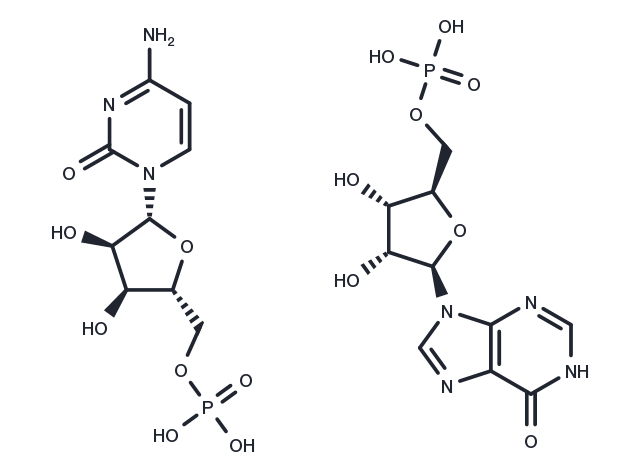Powder: -20°C for 3 years | In solvent: -80°C for 1 year
Polyinosinic-polycytidylic acid (Poly(I:C)) is a double-stranded RNA (dsRNA) and a TLR3 agonist. Polyinosinic-polycytidylic acid induces natural immunity in mammals.

| パッケージサイズ | 在庫状況 | 単価(税別) | |||
|---|---|---|---|---|---|
| サンプルについてお問い合わせ | |||||
| 5 mg | 在庫あり | ¥ 10,500 | |||
| 10 mg | 在庫あり | ¥ 16,500 | |||
| 25 mg | 在庫あり | ¥ 34,000 | |||
| 50 mg | 在庫あり | ¥ 65,000 | |||
| 100 mg | 在庫あり | ¥ 101,000 | |||
| 500 mg | 在庫あり | ¥ 226,500 | |||
| 説明 | Polyinosinic-polycytidylic acid (Poly(I:C)) is a double-stranded RNA (dsRNA) and a TLR3 agonist. Polyinosinic-polycytidylic acid induces natural immunity in mammals. |
| In vitro |
METHODS: Cervical cancer cells HeLa, SiHa, C33A and lung cancer cells A549 were treated with polyinosinic-polycytidylic acid (0.1-1 μg/mL) for 24 h, and cell death was detected using PI Staining. RESULTS: Polyinosinic-polycytidylic acid effectively induced tumor cell death in a dose-dependent pattern. [1] METHODS: Rat astrocytes were pretreated with polyinosinic-polycytidylic acid (10-20 μg/mL) for 12 h, and then exposed to oxygen-glucose deprivation (OGD) for 12 h. The morphology of the cells was examined by microscopy. RESULTS: OGD induced significant cellular damage, and the cells appeared to be healthier in the group pretreated with polyinosinic-polycytidylic acid.Polyinosinic-polycytidylic acid exerted a certain degree of protective effect against OGD-induced damage in cultured astrocytes. [2] |
| In vivo |
METHODS: To investigate the neuroprotective effects in an acute ischemia model, Polyinosinic-polycytidylic acid (0.3 mg/kg) was administered as a single intramuscular injection to Kun-Ming strain mice, and a model of arterial occlusion (MCAO) was constructed 2 h later. RESULTS: Administration of polyinosinic-polycytidylic acid significantly attenuated neurological deficits in the ischemic striatum and cortex, reduced infarct volume, and suppressed the elevation of TNFα and IL-6 levels. [2] METHODS: To test the antitumor activity in vivo, Polyinosinic-polycytidylic acid (1-100 μg/mouse) was intraperitoneally injected into a mouse model of metastatic tumors C57BL/6J induced by cutaneous melanoma B16-F10. RESULTS: Lung tumor growth stopped after a single dose of Polyinosinic-polycytidylic acid. Polyinosinic-polycytidylic acid has potential antitumor activity in an established mouse model of lung metastasis. [3] |
| 別名 | Poly(I:C) |
| 分子量 | N/A |
| 分子式 | (C10H13N4O8P)x.(C9H14N3O8P)x |
| CAS No. | 24939-03-5 |
Powder: -20°C for 3 years | In solvent: -80°C for 1 year
H2O: ≥21.5mg/mL
DMSO: < 1 mg/mL (insoluble or slightly soluble)
You can also refer to dose conversion for different animals. 詳細
bottom
Please see Inhibitor Handling Instructions for more frequently ask questions. Topics include: how to prepare stock solutions, how to store products, and cautions on cell-based assays & animal experiments, etc.
Polyinosinic-polycytidylic acid 24939-03-5 Immunology/Inflammation TLR Toll-like Receptor (TLR) Poly(I:C) Polyinosinic polycytidylic acid Inhibitor inhibit Polyinosinicpolycytidylic acid inhibitor
